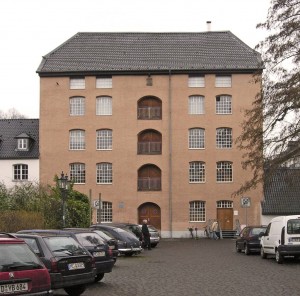I recently visited LVR-Industriemuseum Textilfabrik Cromford, at Ratingen, near Düsseldorf, Germany. The museum is located in the first water-powered cotton spinning mill to be built in continental Europe. It was constructed in 1783-4 by Johann Gottfried Brügelmann, a Wuppertal merchant, to house copies of Richard Arkwright’s water frames. Its five-story Hohen Fabrik now contains working reconstructions of these machines, built specially for the museum in the 1990s by William Haycock of Ashbourne, Derbyshire. The reconstructions are based on the surviving late-eighteenth century machines from Richard Arkwright’s Cromford factory in Derbyshire, which are now preserved at the Helmshore Mills Textile Museum in Lancashire.
The Ratingen museum provides one of the few opportunities to observe how an Arkwright water frame actually worked. Especially striking is the fixed positioning of Arkwright’s famous rollers that draw out the cotton roving for spinning. The lack of adjustment means the machine is limited in the kinds of cotton it can spin, because the distance between the three sets of rollers has to match the staple length of the cotton fibres. Very short staple cotton, of the kind produced in the eighteenth century in the eastern Mediterranean and India from Eurasian varieties of the cotton plant, cannot be spun. The layout of the rollers is optimised for the longer staple cottons which, in the eighteenth century, were available only from the two New World species. This suggests that Arkwright’s early success was heavily dependent on access to longer-staple, New World cotton, mainly from the Caribbean, but increasingly from Brazil.
The video clip above shows the reconstructed water frame at Ratingen in action. Wound around each of the bobbins at the top of the machine is a pre-prepared cotton roving – a long, thin, loosely-wound tube of cotton wool. Each roving is drawn down off its bobbin by a set of three pairs of rollers. They turn at different speeds in a sequence which draws or stretches out the roving. The surface of the lower rollers is ribbed metal; the upper rollers are covered in leather. Each of the three pairs of rollers is weighted. As the attenuated cotton roving leaves the rollers, it is pulled down and spun into yarn by the flyer/spindle mechanism at the bottom of the machine.
Open in full-page view to see the machinery in detail.
The close-ups of the rollers in the video show how they slot into fixed positions in their metal housing. Behind the rollers is a board with metal hooks to guide the roving. It can be seen to move slowly from side to side. This is to ensure that any abrasion is evenly distributed across the upper, leather-covered roller.
Thanks to Claudia Gottfried for showing me the machines at Ratingen.




3 Responses to Richard Arkwright goes to Germany